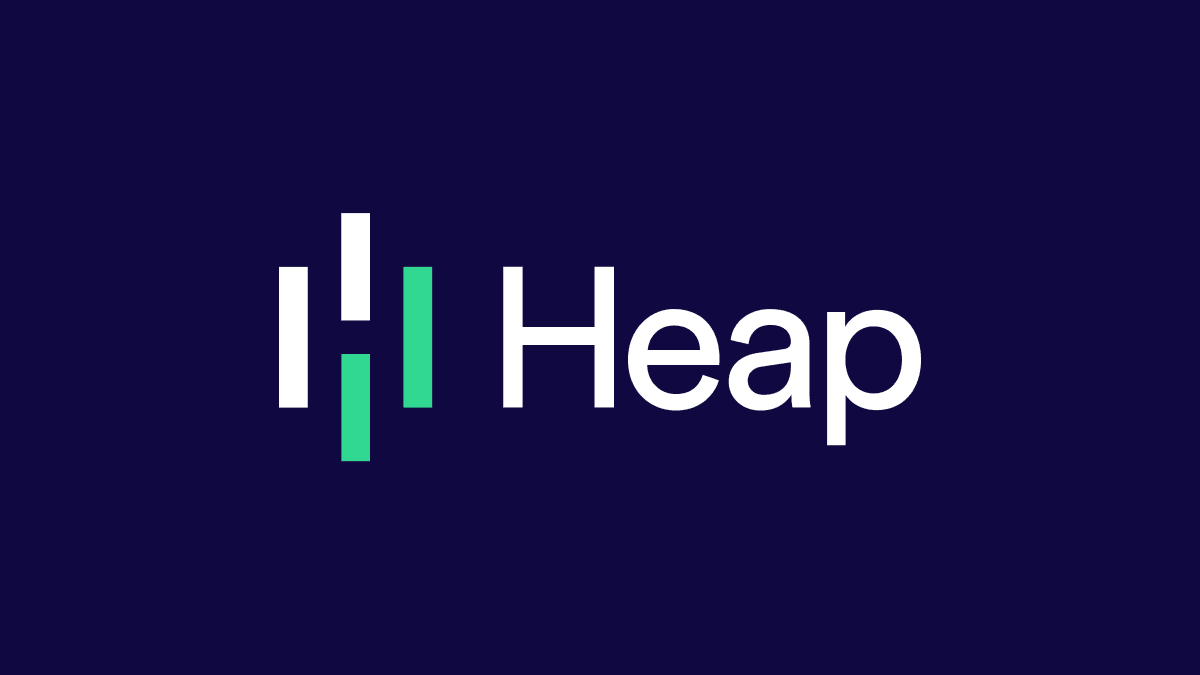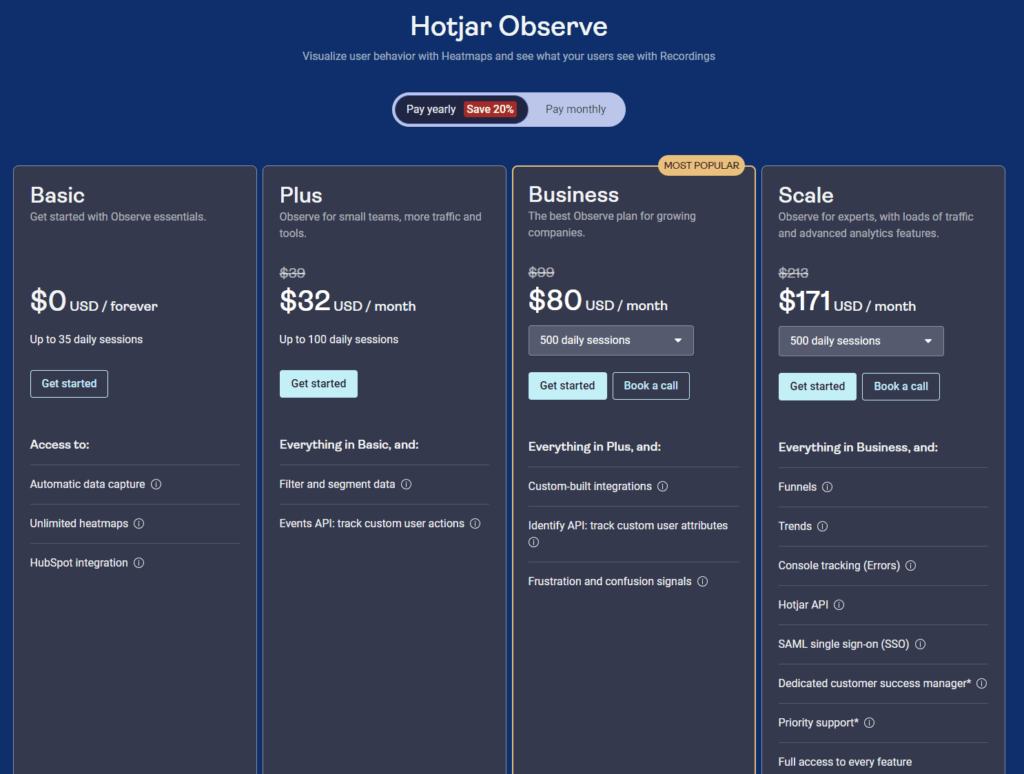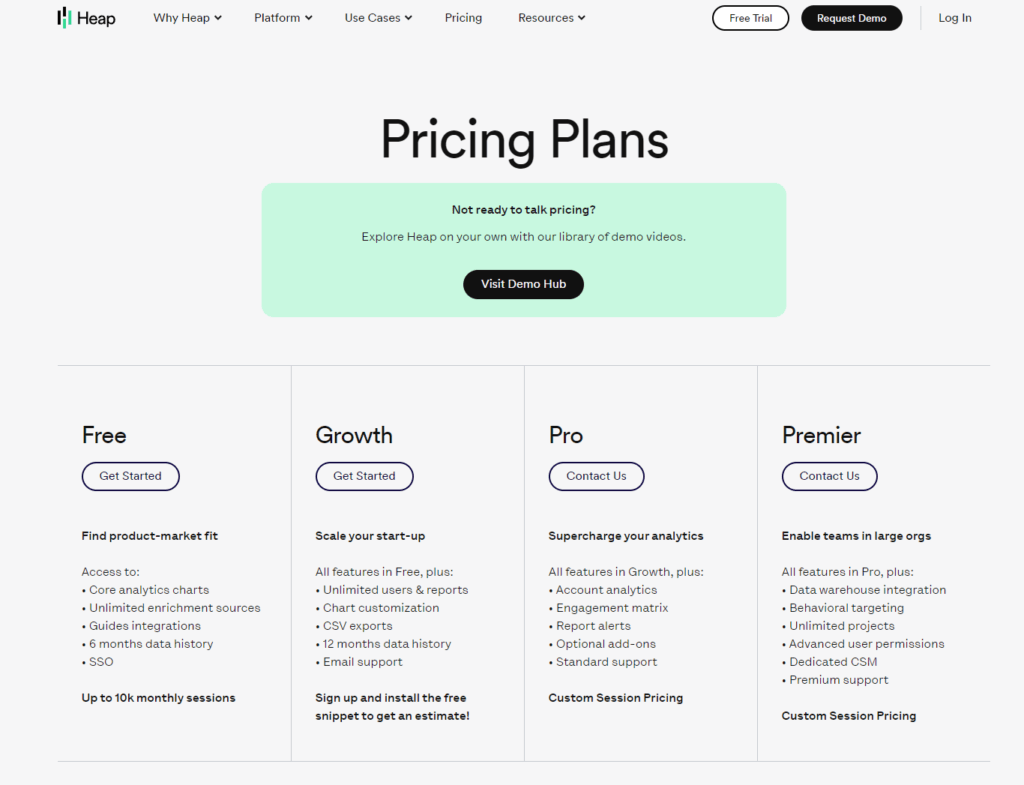In today’s digital landscape, having the right analytics tool is akin to holding a compass in the vast wilderness of the internet. It guides your steps, helping you navigate through the dense forest of data to uncover valuable insights about your users’ behavior. With an overwhelming array of tools available, making the right choice can seem daunting. Among the contenders, Hotjar and Heap stand out, each offering unique features designed to enhance your understanding of user interaction. But which one is the best fit for your needs? Let’s dive into a detailed comparison, starting with a crucial aspect for any website or application
| Hotjar | Heap |
|---|---|
 |  |
| G2 Score – 4.3 out of 5 stars | G2 Score – 4.4 out of 5 stars |
| TrustRadius Score – 8.2/10 | TrustRadius Score – 8.2/10 |
Understanding User Behavior
Hotjar vs Heap
At the heart of any successful website or application lies a deep understanding of user behavior. Knowing how users interact with your platform, where they face difficulties, and what drives their decisions is essential for optimization and growth. Let’s explore how Hotjar and Heap approach this critical area, offering tools and insights to help you map out the user journey.
Hotjar: Visual Insights into User Behavior
Hotjar is renowned for its intuitive, visual-based tools that provide a window into the user’s experience. One of the standout features of Hotjar is its heatmaps, which offer a colorful representation of where users click, scroll, and move on your site. These heatmaps are not just visually appealing; they are a treasure trove of insights, revealing the hotspots of user engagement and areas that may be overlooked.
Furthermore, Hotjar takes the visualization of user behavior a step further with session recordings. Imagine sitting behind your users, watching over their shoulder as they navigate through your site. That’s exactly what session recordings offer, providing a playback of user sessions to identify stumbling blocks, unexpected behaviors, and moments of delight. This feature is invaluable for anyone looking to refine the user experience, making Hotjar a go-to tool for UX enthusiasts and marketers alike.
Heap: Automatic and Comprehensive Event Tracking
While Hotjar focuses on visual insights, Heap takes a different approach by emphasizing automatic event tracking. Right from the get-go, Heap begins tracking every interaction on your site or app without the need for manual setup. This comprehensive data collection ensures that no touchpoint is missed, offering a complete picture of user behavior.
Heap’s magic lies in its ability to retroactively analyze user interactions. Ever had that moment where you wished you had tracked a particular event from the beginning? Heap removes this regret by allowing you to define events after the fact, analyzing historical data to uncover insights. This feature is a game-changer for product managers and marketers, providing the flexibility to adapt analysis as your understanding of what’s important evolves.
Additionally, Heap offers powerful segmentation and funnel analysis tools. These allow you to dive deep into the specifics of user behavior, segmenting by actions, events, or user characteristics. Want to know how users from a particular source behave differently? Or how many users complete a specific journey on your platform? Heap makes this analysis straightforward, providing actionable insights to drive optimization and growth.
Integration and Compatibility
Seamlessly Fitting into Your Tech Stack
In the digital age, the ability of a tool to integrate seamlessly with your existing technology stack is not just a convenience; it’s a necessity. The smoother the integration, the faster you can unlock actionable insights and drive improvements. Let’s compare how Hotjar and Heap fit into this scenario, focusing on their ease of integration and compatibility with other tools and platforms.
Hotjar: Plug-and-Play Simplicity
Hotjar is designed with simplicity in mind, not just in its user interface but also in how it integrates with other platforms. It offers straightforward plug-and-play installation on most websites, requiring only a snippet of code to be added to your site’s header. This ease of setup means you can start collecting valuable user insights in minutes, without needing a developer to get things up and running.
Beyond the basic installation, Hotjar boasts integrations with a wide range of content management systems (CMS), e-commerce platforms, and analytics tools. Whether you’re using WordPress, Shopify, or Google Analytics, Hotjar can easily fit into your workflow, enhancing your ability to understand and optimize the user experience without disrupting your existing processes.
One of Hotjar’s strengths in terms of integration is its focus on complementing data from other analytics tools. By providing visual insights, Hotjar offers a qualitative dimension to the quantitative data you might be gathering from other analytics platforms. This combination can be incredibly powerful, allowing you to balance hard numbers with visual user feedback to make informed decisions.
Heap: Deep Integration for Data-Driven Decisions
Heap takes integration a step further by offering deep connections with your tech stack that enable a more automated and comprehensive analysis of user behavior. Similar to Hotjar, setting up Heap involves adding a code snippet to your site, but the similarities end there. Heap’s integrations are designed to pull in data from across your digital ecosystem, offering a unified view of user interactions that spans websites, mobile apps, and even cloud services.
One of the standout features of Heap’s integration capabilities is its ability to work seamlessly with other analytics and marketing tools. From Salesforce to Optimizely, Heap can connect with a variety of platforms, allowing you to enrich your customer data and automate workflows across your tools. This level of integration is particularly beneficial for businesses looking to leverage advanced analytics and marketing strategies, as it provides a holistic view of the customer journey across multiple touchpoints.
Furthermore, Heap’s focus on automation extends to its data collection, meaning once it’s set up, it continuously captures data on new events and interactions without the need for manual intervention. This automatic tracking ensures that your data analysis is always up-to-date, allowing for real-time insights and adjustments to your strategy.

Related: Check out our free SEO suite

Conversion Rate Optimization
Hotjar vs Heap
Conversion Rate Optimization is the art and science of getting more of your visitors to take the desired actions on your website or app. Whether it’s signing up for a newsletter, making a purchase, or filling out a contact form, CRO is about understanding what drives, stops, and persuades your users. Let’s see how Hotjar and Heap equip you with the tools to master CRO.
Hotjar: Direct Feedback for Actionable Insights
Hotjar shines in CRO through its direct feedback tools, which complement its visual analytics features. Understanding that the path to conversion is not just about what users do but also about how they feel, Hotjar offers features like surveys and feedback widgets. These tools allow you to collect direct input from your users, giving you qualitative data about their experiences, frustrations, and desires.
Surveys can be targeted to appear at specific moments, such as after a user completes an action or if they’re about to exit your site. This timing ensures that you’re capturing feedback that is relevant and tied to specific experiences on your site. Similarly, feedback widgets let users report issues or offer suggestions at any point in their journey, providing you with ongoing insights into areas for improvement.
These direct feedback mechanisms are invaluable for CRO, as they allow you to understand the ‘why’ behind user behaviors. Armed with this information, you can make targeted changes to your site, addressing user concerns, enhancing the user experience, and ultimately, improving your conversion rates.
Heap: Data-Driven Decisions to Optimize Conversions
Heap’s approach to CRO is deeply rooted in its comprehensive event tracking and data analysis capabilities. By automatically capturing every interaction, Heap allows you to construct detailed conversion funnels and identify where users are dropping off. This level of detail is critical for pinpointing the specific stages in the user journey that need optimization.
Furthermore, Heap’s advanced segmentation features come into play, enabling you to dissect your funnel analytics by various user characteristics or behaviors. This segmentation allows you to perform cohort analysis, comparing how different groups of users move through your conversion funnels. Such insights can uncover opportunities for personalized optimization strategies, ensuring that you’re not just improving overall conversion rates but are also addressing the needs of different user segments.
Heap’s strength in CRO lies in its ability to let data guide your optimization efforts. By understanding the nuances of how different users interact with your site, you can make informed changes that resonate with your audience, remove barriers to conversion, and enhance the overall effectiveness of your CRO strategies.
Integration Capabilities and Ecosystem Compatibility
In the modern digital landscape, the ability of an analytics tool to seamlessly integrate with other tools and services is not just a convenience—it’s a necessity. The true power of analytics comes from combining data across platforms to gain a holistic view of user behavior, marketing effectiveness, and product performance. Let’s compare Hotjar and Heap in terms of their integration capabilities and how well they play with other tools in the digital ecosystem.
Hotjar: Streamlining UX Insights with Key Integrations
Hotjar, known for its user-friendly approach to visual analytics, extends this simplicity to its integration capabilities. It offers direct integrations with a variety of platforms, including content management systems (CMS), e-commerce platforms, and digital marketing tools. These integrations allow for a smooth flow of data between Hotjar and other tools, enabling teams to correlate UX insights with other key performance indicators.
One of the strengths of Hotjar’s integration capabilities is its focus on enhancing the user experience design process. By integrating with tools such as WordPress, Shopify, and HubSpot, Hotjar allows UX designers and marketers to directly apply insights gained from heatmaps and session recordings to improve website and landing page performance. Furthermore, Hotjar supports integration with project management and team collaboration tools, making it easier to share insights and foster a data-driven culture within organizations.
However, while Hotjar covers the basics well, its integration ecosystem may not be as expansive as some data-heavy analytics platforms. Its strength lies in providing targeted insights that are immediately actionable, especially useful for teams focused on quick wins and iterative improvements in user experience.
Heap: A Hub for Data-Driven Decision Making
Heap takes a more comprehensive approach to integrations, positioning itself as a central hub for data-driven decision-making. It boasts a wide array of integrations with not just marketing and sales platforms but also product management and customer success tools. Heap’s integration strategy is designed to automate the collection and synchronization of user data across various touchpoints, providing a unified view of the customer journey.
One of the notable features of Heap’s integration capabilities is its flexibility in connecting with data warehouses and business intelligence (BI) tools. This allows organizations to merge Heap’s detailed event data with other business data, facilitating advanced analyses that drive strategic decisions. For example, integrating Heap with Salesforce or Marketo can unlock powerful insights into how user behavior on the product influences sales pipelines or marketing campaigns.
Moreover, Heap’s ability to integrate with A/B testing and experimentation platforms enhances its value for product teams. By correlating in-depth user behavior analytics with experiment results, teams can make data-backed decisions to optimize product features and user journeys.
Pricing
Hotjar

Heap

Conclusion
Hotjar shines with its intuitive, visual-based insights into user behavior, making it an excellent choice for teams focused on enhancing UX and UI. Its heatmaps, session recordings, and straightforward conversion funnel analyses provide clear, actionable insights that can drive immediate improvements. Coupled with its user-friendly integrations, Hotjar is particularly suited for teams seeking to quickly iterate on user experience and collaborate effectively on UX design improvements.
Heap, on the other hand, distinguishes itself with its comprehensive event tracking and deep analytical capabilities. Its automatic data capture and retroactive analysis functionality offer a robust foundation for data-driven decision-making. Heap’s extensive integration ecosystem allows it to serve as a central hub for analyzing user behavior across various platforms, making it ideal for organizations that prioritize a unified view of the customer journey and in-depth, segmented analyses.
Read Next:
- Is The Quora Partner Program Going To Make Me Money?
- 8 Content Amplification Tips to Maximize Lead Generation
- How to Hire the Best SEO Services: Industry Review
- Skyrocket Your Email Outreach ROI! Strategies (+Experiments) By 19 Experts
- 31+ Top Social Media Management tools Compared! (2023)




















Comments are closed.